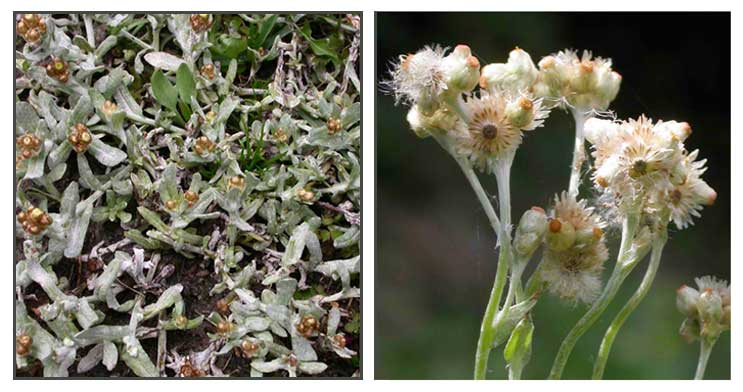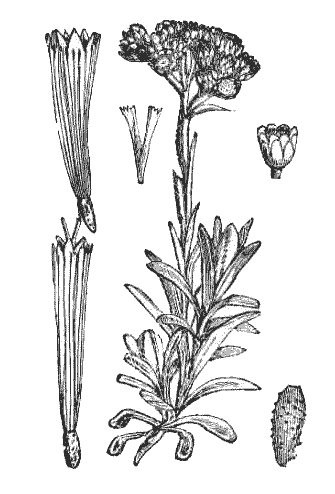
Family • Asteraceae
Badok
Pseudognaphalium luteoalbum (L.) Hilliard & B.L.Burtt
JERSEY CUDWEED
Si mian cao
| Scientific names | Common names |
| Dasyanthus conglobatus (Lam.) Bubani | Badok (Ilk.) |
| Flaginella luteoalba (L.) Opiz | Bunut (Ig.) |
| Gnaphalium alboluteum Roxb. | Onanat (Ig.) |
| Gnaphalium conglobatum Lam. | Tugong (If.) |
| Gnaphalium dealbatum var. luteofuscum (Webb) Lobin | Cudweed (Engl.) |
| Gnaphalium depressum Steud. | Everlasting cudweed (Engl.) |
| Gnaphalium diffusum Baker | Fragrant cudweed (Engl.) |
| Gnaphalium gracile Blume | Jersey cudweed (Engl.) |
| Gnaphalium javanicum DC. | Red-tip rabbit-tobacco (Engl.) |
| Gnaphalium leontopodinum Bory ex DC. | Weedy cudweed (Engl.) |
| Gnaphalium luteoalbum L. | |
| Gnaphalium luteoalbum var. depressum Lej. | |
| Gnaphalium luteoalbum var. glandulosum Walp. | |
| Gnaphalium luteoalbum var. glomeratum Porta | |
| Gnaphalium luteoalbum var. incanum A.Rich. ex Endl. | |
| Gnaphalium luteoalbum var. occidentale Nutt. | |
| Gnaphalium luteoalbum var. pallidum Hook.f. | |
| Gnaphalium luteofuscum Webb. | |
| Gnaphalium luteolum E.H.L.Krause | |
| Gnaphalium martabanicum Wall. | |
| Gnaphalium molle Salisb. | |
| Gnaphalium orixense Roxb. | |
| Gnaphalium pallidum Lam. | |
| Gnaphalium pompejanum Ten. | |
| Gnaphalium reinwardtianum Miq. | |
| Gnaphalium sphaericum Perr. ex DC. | |
| Gnaphalium trifidum Thunb. | |
| Helichrysum conglomeratum Moench | |
| Helichrysum luteoalbum (L.) Rchb. | |
| Laphangium luteoalbum (L.) Tzvelev | |
| Pseudognaphalim luteoalbum (L.) Hilliard & B.L.Burtt | |
| Pseudognaphalim luteoalbum var. pallidum (Lam.) Karthik & Moorthy | |
| Pseudognaphalim luteoalbum subsp. turcicum Yild. | |
| Laphangium luteoalbum is a synonym of Pseudognaphalium luteoalbum (L.) Hilliard & B.L.Burtt. | |
| Pseudognaphalium luteoalbum (L.) Hilliard & B.L.Burtt. is an accepted species: KEW: POWO | |
| Other vernacular names |
| ANGOLA: Otchimbwangongo |
| ARABIC: Kutaina, Raraa, Sabon Efreet. |
| BANGLADESH: Jabra. |
| CATALAN: Borrosa, Gnafali groguenc, Peludarda(Catalan). |
| CHINESE: Si mian cao. |
| CROATIAN: Zutobijela smilika. |
| CZECH: Protnice zlutobila, Protez zlutobila. |
| DANISH: Gulhvid evighedsblomst. |
| DUTCH: Bleekgele droogbloem. |
| FINNISH: Kulegraurt, Valkojäkkärä. |
| FRENCH: Cotonniere blanc-jaunatre, Gnaphale blanc jaunatre, Gnaphale jaunatre, Gnaphale jaune blanc, Immortelle des marais. |
| GERMAN: Gelblichweisses ruhrkraut, Gelbweibes scheinruhrxkraut, Gelbruhrkraut. |
| HEBREW: Livdanit tzehavhevet. |
| HUNGARIAN: Halvany gyopar. |
| ITALIAN: Canapicchia pagilata, Gnafalio bianco. |
| JAPANESE: Seitakachichikogusa, Seitakahahakogusa. |
| LITHUANIAN: Gelsvasis pukelis. |
| NIGERIAN: Okababa, Dawa, Jero, Sorgum. |
| POLISH: Szarota zoltobiala. |
| PORTUGUESE: Erva-cotoneira, Perpetua-brava, Perpetua-silvestre, Perpetuas-bravas, Picanceira, Tomentosa. |
| SLOVAKIAN: Paplesnivcek Zltobiely, Plesnivec piesocny. |
| SLOVENE: Rumenkasti grizevec. |
| SPAIN: Borossa (Galician), Algondonosa, Algonosa, Borriza, Borrosa, Copa real de plata e oro, Hierba del tomento, Ropa limpia, Yerba del tomiento. |
| SWEDISH: Vitnoppa. |
Botany • Annual herb to 50 cm tall, all parts whitish-woolly. Stems usually several from the base, decumbent at first, later erect. Leaves sessile, up to 8 × 1 cm at base, oblanceolate, becoming smaller and lanceolate or linear above, greyish or whitish tomentose or arachnoid, on both sides; margin entire. Inflorescence consisting of dense clusters of capitula 1-several together in terminal corymbs. Involucres 3-4 mm in diameter; phyllaries in c. 3 rows, pale brown to whitish. Outer female florets very numerous, whitish. Bisexual disk florets cylindric. Achenes ellipsoid, papillose. Pappus of numerous soft bristles. (Flora of Zimbabwe)
- Leaves considered astringent, cholagogue, diuretic, febrifuge, hemostatic and vulnerary. - Studies have suggested antiseptic, antifungal, cytotoxicity, antioxidant properties. Constituents Studies Availability |
Updated November 2024 / June 2019 / October 2016
![]()
 |
PHOTOS / ILLUSTRATIONS |
| IMAGE SOURCE: 2 Photos / Asteraceae : Gnaphalium luteoalbum / habit of flowering plant / Copyright © 2010 by P.B. Pelser (contact: pieter.pelser@canterbury.ac.nz) [ref. DOL19419] / Click on image to go to source page / Non-Commercial Use / Phytoimages.siu.edu |
| OTHER IMAGE SOURCE: Gnaphalium luteo-album / Walter Hood Fitch - Illustrations of the British Flora (1924) / Permission granted to use under GFDL by Kurt Stueber. Source: www.biolib.de / GNU Free Documentation License / alterVISTA |
| OTHER IMAGE SOURCE: Jersey cudweed (Gnaphalium luteoalbum) flowers / © Joseph M DiTomaso / CC B Y-NC / Non-commercial use / Click on image or link to go to source page / Invasive.Org |
| OTHER IMAGE SOURCE: Jersey cudweed (Gnaphalium luteoalbum) Infestation / © Joseph M DiTomaso / CC BY-NC / Non-commercial use / Click on image or link to go to source page / Invasive.Org |
Additional
Sources and Suggested Readings |
• |
DOI: It is not uncommon for links on studies/sources to change. Copying and pasting the information on the search window or using the DOI (if available) will often redirect to the new link page. (Citing and Using a (DOI) Digital Object Identifier) |
| List of Understudied Philippine Medicinal Plants |
| New plant names needed The compilation now numbers over 1,500 medicinal plants. While I believe there are hundreds more that can be added to the collection, they are becoming more difficult to find. If you have a plant to suggest for inclusion, native or introduced, please email the info: scientific name (most helpful), local plant name (if known), any known folkloric medicinal use, and, if possible, a photo. Your help will be greatly appreciated. |
• |
 |
• |



 Distribution
Distribution
